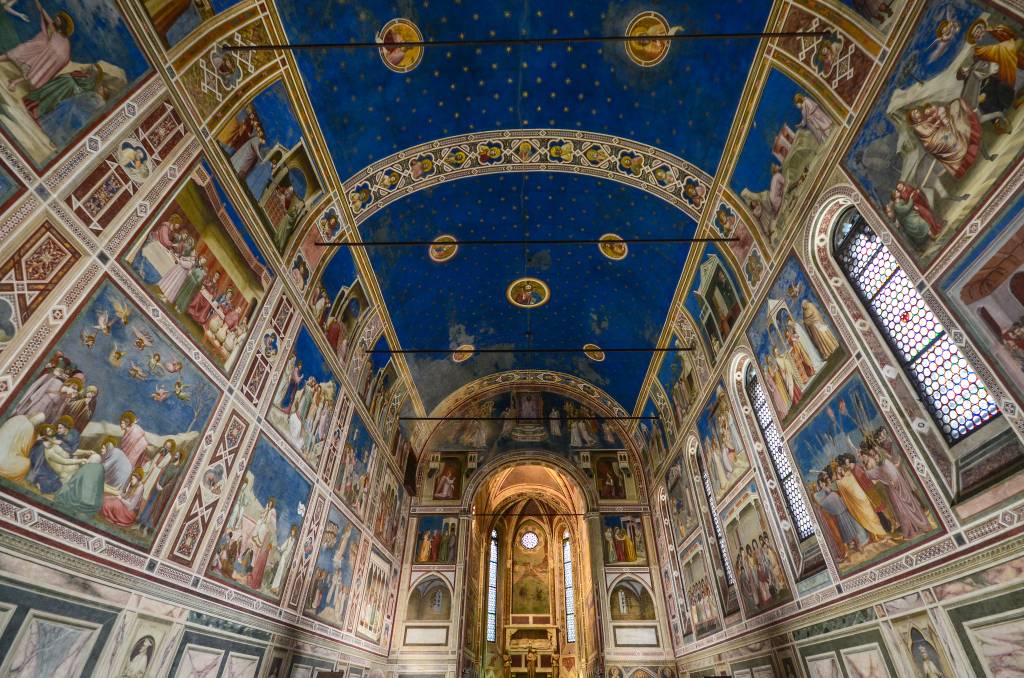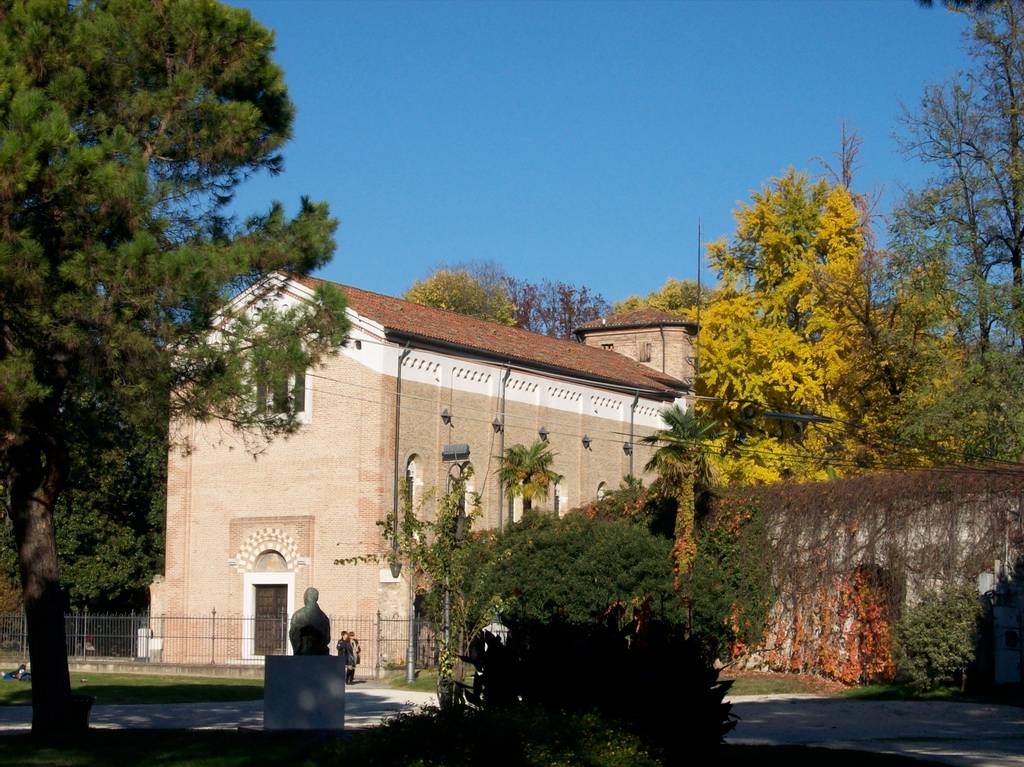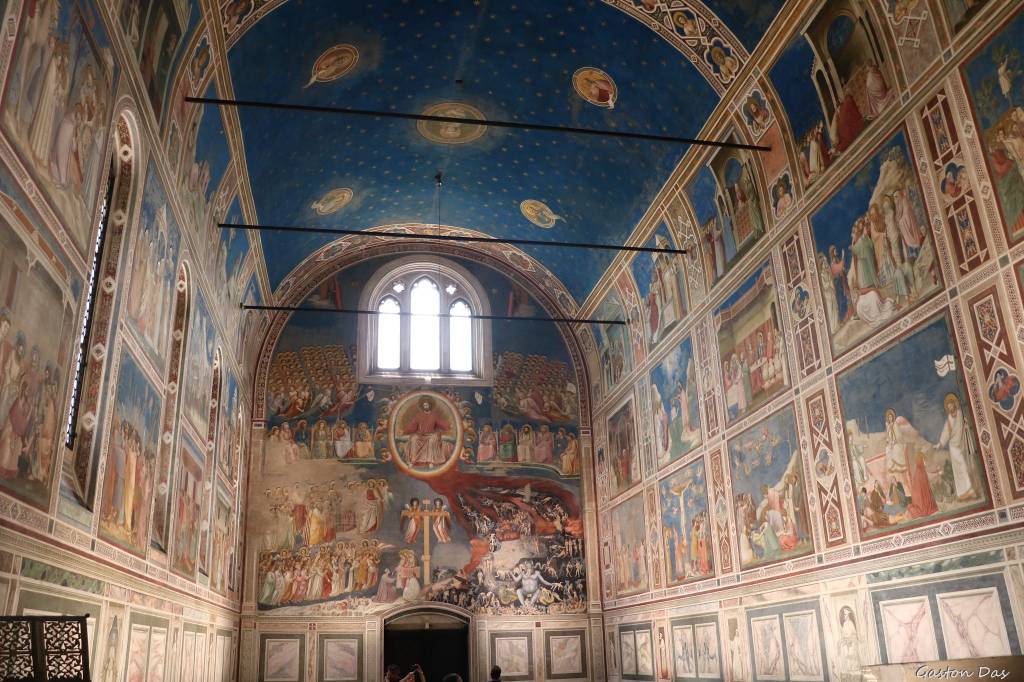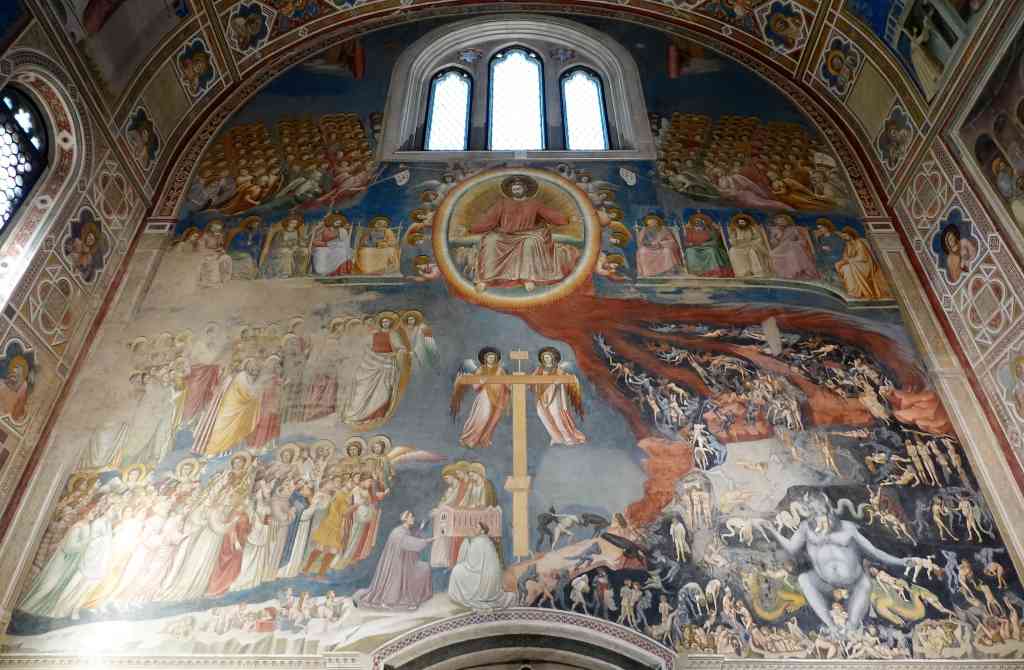Scrovegni Chapel
The Scrovegni Chapel houses one of the most outstanding masterpieces of figurative art of all time, the complete fresco cycle created by Giotto

In 1302, at the height of his artistic maturity, Giotto was called to Padua by the Friars of Conventual Franciscans to paint a series of frescoes in the Basilica of Saint Anthony, recently built and in the process of being completed.
At the end of these works, the Florentine Master was hired by Enrico Scrovegni – a wealthy banker who had bought the land of the Roman Arena a few years earlier, where he had built a sumptuous palace – to paint the interior of his family chapel.
His father, Reginaldo Scrovegni, accumulated a vast fortune through usury, a practice highly condemned by the Catholic Church. Heir to the inheritance left to him, Enrico had the chapel built with the idea of redeeming his father's sins and making it a family mausoleum dedicated to the Virgin Mary.
Therefore, he hired the best artists available on the market to decorate it: Giovanni Pisano, who created three splendid statues placed on the altar, The Madonna with Child between two Angels, and Giotto, who painted an extensive series of paintings inspired by one of the most popular religious works of the Middle Ages, The Golden Legend by Jacopo da Varazze.
The Scrovegni Chapel has a simple architecture: it is a rectangular room with a barrel vault, which ends with a polygonal apse that includes the altar and a bell tower.
Initially connected to the Palazzo Scrovegni, the structure is asymmetrical, having six tall and narrow windows only on the south wall. The facade is characterised by exposed bricks and has an elegant Gothic mullioned window in the upper part.
The interior is a single nave, interrupted in the middle by two side altars, and ends with a chancel where the sarcophagus of Enrico Scrovegni is located.
Above the altar was a crucifix painted in tempera by Giotto on a poplar panel, now preserved in the Eremitani Civic Museums. The Cross, made in 1304, is painted on both sides and features a series of refined plant motifs. On each hand of Christ are depicted Mary and Saint John the Apostle.
The fresco cycle
The main series of paintings tells the story of the salvation of humanity through 38 scenes that could be read like a book, distributed in three rows, and developed into three main themes: the events from the life of Joachim and Anna, the events from the life of Mary, and the events from the life and death of Christ.
The first theme dealt with is that of the stories of Joachim and Anna, Mary's parents, and is located at the top, on the south wall, looking at the altar. It was a very rare theme in Giotto's time. It represents almost a unicum: Joachim, now elderly and childless, is expelled from the temple because sterility was considered a real dishonour. He moves away from his home and takes refuge in the mountains, where he remains for five months, without giving any news of himself. One night, Joachim has a vision of an angel urging him to return to Jerusalem. He reunites with Anna, his wife, in a touching and moving scene back in the city.
On the upper register of the north wall, Giotto recounts the life of Mary: her birth, her growth, and her confinement in the temple of Jerusalem where she lives as a nun. The scenes tell the story of her betrothal to Joseph through the miracle of the flowering rods: every man should bring a rod to the Temple, one of the rods will flower, and its owner will be able to take Mary as his wife. The candidates are all young, except for Joseph, depicted with a beard and a halo, waiting patiently.
On the third register, the most important, there are the episodes from the life and death of Christ. Among these, three panels deserve particular attention, which stands out for their intensity and realism: The kiss of Judas, The Crucifixion, and The Lamentation over the Dead Christ.
The pictorial cycle also continues in the lower part of the walls with 14 allegorical figures representing Vices and Virtues. To divide the various figures, Giotto used fake marble, an absolute novelty for the time, made with a technique inspired by the work of ancient Rome classical painters and no longer used for centuries.
The vault of the chapel, painted with the famous ultramarine blue, simulates the starry sky in which Christ and the Madonna and Child are depicted inside gilded circles among the evangelists and prophets. In the counter facade is the majestic scene of The Last Judgment.
The kiss of Judas
The scene is depicted outdoors and shows Judas, dressed in yellow, leaning forward to kiss Jesus, allowing the soldiers to locate Christ. The setting is theatrical, full of strong emotions given by the meeting of gazes between Jesus and Judas and by the excitement of the guards.
The Crucifixion
On a background of a very intense blue, the scene illustrates in the centre the cross with the body of Jesus, the angels rushing to collect the blood that drips from his wounds, and Magdalene kissing Jesus' feet. Mary, overwhelmed by pain, is supported by a group of women, while on the other side, the soldiers gamble for the clothes of Jesus.
A skull and bones are placed at the base of the Cross. They belong to Adam, emerging from a cavity at the foot of Calvary, and which, bathed in the blood of Christ, are redeemed from original sin.
The lamentation over the dead Christ
The emotional scene unveils the intense embrace of the Madonna to her dead son at the deposition from the Cross.
Mary embraces Jesus as if she did not want to let him go, Magdalene supports his feet, while John gives a cry of pain and the angels appear incredulous and desperate in heaven.
The scene is painted in light and bright colours contrasting with the dramatism of the story, which sends a message of hope.
The Last Judgment
A single outstanding scene is painted in the counter-facade, The Last Judgment.
Christ is placed in the centre, surrounded by the Angels and the Apostles. Below, two angels lift the cross, while Enrico Scrovegni offers the Madonna a Chapel model.
A singular face stands out among the blessed, a character with a yellow headdress: Giotto himself has a self-portrait. The corpses of the dead come out of the graves and are led towards Christ, who opens a hand in mercy on one side, and the other turns it to Hell, where sinners are rolled into the flames, from which emerges the devil and his court of demons.
The fresco served as a warning to the faithful, who were mostly illiterate and did not understand the sermon in Latin. The portrayal of the day of judgment did not need explanation; the incredible detail in representing the pains dedicated to sinners and the happiness of the righteous were evident.
Giotto's Last Judgment is regarded as one of the supreme masterpieces of the Early Renaissance. It has been taken as a model by all the artists, including Michelangelo, who in later times have ventured into the representation of this theme.
The Technological Building
The Technological Building is a structure connected to the Scrovegni Chapel. It allows access through the ancient passage that once led to the Palazzo Scrovegni.
The structure serves to keep the internal microclimate of the chapel unaltered, protecting it from pollution through a system with three compartments and a ventilation system that keeps the temperature and humidity conditions stable. For this reason, the access is limited to a maximum of 25 visitors and the visits are only possible upon reservation.
We welcome all contributions, no matter how small. Even a spelling correction is greatly appreciated.
All submissions are reviewed before being published.
Continue to changelog-

© 'Capella degli Scrovegni' by guido_agostini is licensed under CC BY-NC 4.0 Attribution copied to clipboard Failed copying attribution to clipboard -

© 'システィーナ礼拝堂 Scrovegni Chapel' by annintofu is licensed under CC BY-NC-ND 4.0 Attribution copied to clipboard Failed copying attribution to clipboard -

© 'IMG_7502' by Gaston Das is licensed under CC BY-NC-SA 4.0 Attribution copied to clipboard Failed copying attribution to clipboard -

We welcome all contributions.
All submissions are reviewed before being published.
We welcome all contributions, no matter how small. Even a spelling correction is greatly appreciated.
All submissions are reviewed before being published.
Continue to changelogWe welcome all contributions, no matter how small. Even a spelling correction is greatly appreciated.
All submissions are reviewed before being published.
Continue to changelogWe welcome all contributions, no matter how small. Even a spelling correction is greatly appreciated.
All submissions are reviewed before being published.
Continue to changelogCategory
Cost
-
The Roman Arena of Padua was an amphitheatre used for gladiator games in the ancient Patavium. The Arena ruins are now part of the Giardini dell'Arena park.
-
113 m
The most important Paduan complex of museums features the Archaeological Museum and the Museum of Medieval and Modern Art in a charming former convent.
-
113 m
Part of the Eremitani Civic Museums complex, the palazzo houses the Museum of Applied and Decorative Arts and the Bottacin Museum in its rooms.
-
160 m
The church, partially destroyed in 1944, preserves the remains of the splendid frescoes painted by Guariento and Andrea Mantegna
-
In Padua, the pedestrian streets from the city centre are known as Liston, an area extending from Piazza Garibaldi all along to Prato della Valle.



